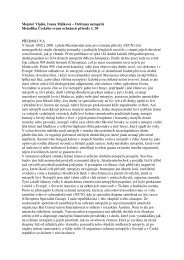Venkovská krajina 2008 - Veronica
Venkovská krajina 2008 - Veronica
Venkovská krajina 2008 - Veronica
You also want an ePaper? Increase the reach of your titles
YUMPU automatically turns print PDFs into web optimized ePapers that Google loves.
The most significant development of the commercial suburbanization was also noticed in<br />
the rear of Prague with obvious ties to important roads. The highest increase in commercial<br />
areas and entertainment centres or logistical warehouses occurred in the immediate<br />
surroundings of the D1 highway, firstly in the municipalities of Čestlice, Modletice and<br />
Průhonice. The commercial build-up in the land registrers in Hostivice, Kněževes, Rudná,<br />
Nučice and Loděnice along the D5 highway; or more precisely in the municipalities of<br />
Klíčany and Panenské Břežany near the D8 highway and in the municipality of Dochov<br />
near the D11 achieved nearly the same dimensions. In the rear of Brno the process of<br />
suburbanization achieved the highest dimensions in the municipality of Modřice with an<br />
extraordinarily advantageous logistical position and further in Šlapanice and Jiříkovice. In<br />
case of other bigger cities a more remarkable increase in commercial zones was recorded<br />
round Mladá Boleslav, Ústí nad Labem, Plzeň, České Budějovice and Pardubice, and less<br />
in the broader surrounding of Olomouc a Ostrava.<br />
A suitable transit position plays a key role just by the construction of some commercial<br />
areas, especially logistical centres. An increase in so exploited areas in the municipality of<br />
Vystrkov u Humpolce at the intersection of the D1 highway and the road number 34 is<br />
a good example. A similar placement of mentioned warehouses and centres arose along<br />
significant roads even in bigger distances from major sites, p.e. in Vranov and Hvězdnice near<br />
D1 or in Žebrák near D5. The reasons for enormous growths of commercial build-up<br />
ca nnot be clearly assessed without a detailed examination in Újezd u Rosic and Rapotice<br />
not far from Brno or in the cadastral units of Hory, Jenišov and Nové Sedlo near Karlovy<br />
Vary. These changes as well as a number of others dispersed all over the Czech Republic<br />
cannot be assessed as a part of suburbanization processes with regard to the absence of<br />
a relation to the residential centre.<br />
Some results of the spatial suburbanization placement analysis are necessary to be judged<br />
critically. By the classification of the suburban scenes for the CORINE LC database p.e.<br />
a merger of existing garden and orchard areas with a new continuous built-up area could<br />
have occurred and the final change therefore presents an enormous growth of areas.<br />
A counter misguided result can be a merger of the existing residential build-up with newly<br />
constructed commercial areas in the 121 class of Industrial and commercial zones which<br />
results in a total fall in areas of the continuous municipal build-up.<br />
It is therefore necessary to assess the mentioned methodical procedure and achieved<br />
results with respect to predicative ability and accuracy of processed data. Nevertheless it is<br />
an assessment of the suburbanization spatial extent on a national scale which is easily<br />
accessible as for data and methodically quickly manageable.<br />
Conclusion<br />
Suburbanization definitely belongs to the most significant landscape processes at present<br />
as well to the most severe problems of the current landscape planning. Its development does<br />
not only lead to changes in the natural components of landscape, energy and material flows<br />
but the modification of the method of landscape use and physiognomy changes also its<br />
cultural aspect and implicitly spiritual and aesthetical values. We suppose that this issue has<br />
been despite its relevance so far neglected by landscape-ecological experts, although loads<br />
of information on the impacts of this process on the landscape in the widest sense exists<br />
abroad.<br />
The aim of the mentioned paper was to introduce possible methods of spatial distribution<br />
assessment of the suburbanization process in terms of the state territory and the results of<br />
alteration database analysis. On the basis of the mentioned outputs the territories concerned




